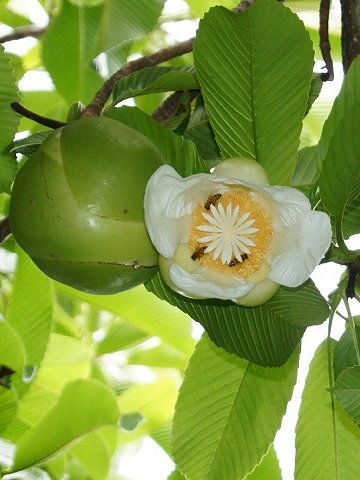
|
|
Elephant apple
(Dillenia indica). Flower and fruit.
|
Elephant apple - Dillenia indica
Dillenia indica, commonly known as elephant apple, is a species of Dillenia native to China and tropical Asia. It is native to southeastern Asia, from India and Sri Lanka east to southwestern China and Vietnam, and south through Thailand to Malaysia and Indonesia. Cultivated in the Philippines.
It is an evergreen large shrub or small to medium-sized tree with a spreading canopy,
that can grow up to 30 metres tall, though is usually smaller
(15 metres). The bole can be 120cm in diameter, often branching from low down. The leaves are
15-36 cm long, with a conspicuously corrugated surface with impressed veins.
Flowers arise solitary at the ends of the twigs, facing downward. The sepals are rounded and yellowish green.
The flowers are large, 15–20 cm diameter, with five white petals and numerous yellow stamens.
Its characteristic round fruits are large, greenish yellow, have many seeds and are edible. The fruit is a 5–12 cm diameter aggregate of 15 carpels, each carpel containing five seeds embedded in an edible but fibrous pulp.
The fruit pulp is sour and used in Indian cuisine in curries, jam (ouu khatta), and jellies.
Dillenia indica produces a large hard fruit which is accessible only to the megaherbivores. A study in the Buxa Tiger Reserve by ecologists Sekar & Sukumar has shown that Asian elephants appear to have a particular fondness for the fruits of D. indica, and are hence an important seed disperser for this tree. With the prospect of extinction of the elephants this tree has developed a back-up system, whereby its hard fruits that were only accessible to megaherbivores, slowly soften on the forest floor through the dry season to allow access to successively smaller animals such as macaques, rodents and squirrels. Seeds from both old and soft fruits are able to germinate well, enabling the persistence of this tree to be independent of the survival of its major megaherbivore disperser.
Because it is a main source of food for elephants, monkeys and deer, collection of fruit from the core areas of the forest are prohibited. Commercial sale of the fruit is also prohibited in an effort to help the food-chain system of the forest from dismantling totally.
Elephant apple is a very ornamental tree. It is often grown in gardens, where it is highly prized for its large, handsome and fragrant flowers, as well as for its edible fruit. The plant provides an edible fruit, polish, soap and medicines for the local people.
Fruits can be eaten raw or cooked. The bulk of the fruit actually consists of thick sepals, which have a sour taste and used in dal and fish preparations and often mixed with coconut and spices to make chutneys. The unripe fruits are also pickled. The aromatic (almost onion-like), acid, juicy fruit pulp (jelly like) is bitter-sour and used in curries, jam (ouu khatta), jellies, drinks or fermented into vinegar.
The aromatic, acid, juicy fruit is usually used in curries, preserves, drinks or fermented into vinegar. The fruits have a similar taste and flavour to unripe apple. The bulk of the fruit actually consists of the very thick sepals, which have a very sour taste. The smaller, juicy fruits inside are also sour. The green fruit is about 10cm in diameter.
Calyces can be eaten raw or cooked. Fleshy, with an agreeable acid flavour, though the large amount of fibre they contain is objectionable. They can be used in curries or made into drinks, jellies and sherbet.
The tree is widely used in Ayurveda and Siddha. It is one of the widely used folk medicinal plant by various tribes of entire North-East.
The leaves, bark, fruits and other parts possess wide range of activity (antimicrobial, antioxidant, analgesic, anti-inflammatory, dysentery, antidiabetic etc.). The fruit pulp is used as tonic and laxative, treatment of abdominal disorders, mixed with sugar against coughs. The bark and leaves are used as laxative and astringent; bark as a mouthwash to treat thrush. The plant parts are also used for treatment of diabetes and cancer.
The fruits can be rubbed in water to make a soap. The pulp is used as a hair wash.
The leaf juice is applied to the scalp to prevent baldness.
The dried leaves are used to polish ivory. Its branches are used to make good firewood.
The wood ash is added to clay bricks to increase their fire resistance.
Source:
https://en.wikipedia.org/wiki/Dillenia_indica
http://tropical.theferns.info/viewtropical.php?id=Dillenia+indica
http://www.flowersofindia.net/catalog/slides/Elephant%20Apple.html
https://starofmysore.com/tree-facts-elegant-elephant-apple/
